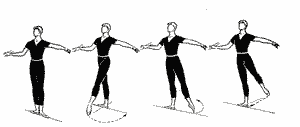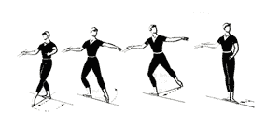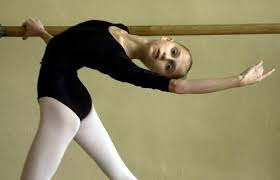Developpé: A movement in which the leg is first lifted to retiré position, then fully extended passing through attitude position. It can be done in front (en avant), to the side (à la seconde), or to the back (derrière).
Enveloppé: enveloped
Pirouette: Literally means to "whirl"; A controlled turn on one leg, starting with one or both legs in plié and rising onto demi-pointe (usually for men) or pointe (usually for women).
Petit Allegro: Petit meaning small. Allegro meaning brisk, lively. A term applied to all bright, fast, or brisk movements.
Grand Allegro: Grand meaning large. Allegro meaning brisk, lively. A term applied to all bright, fast, or brisk movements.
Lace Up: A Ballerina's Journal
Tuesday, November 27, 2012
Five Classes of Jumps
Saut(2-2): jump
Jeté(1-other): Throwing step. A jump from one foot to the other in which the working leg is brushed into the air and appears to have been thrown.
Temps Levé(1-same): a hop from one foot with the other raised in any position. The instep is fully arched when leaving the ground and the spring must come from the pointing of the toe and the extension of the leg after the demi-plié.
Assemblé(1--> 2): launching into a jump, the second foot then swishes up under the first foot. The feet meet together in mid-air, and the dancer lands with both feet on the floor at the same time, in third or fifth position.
Sissonne(2--> 1): A jump done from two feet to one foot.
Jeté(1-other): Throwing step. A jump from one foot to the other in which the working leg is brushed into the air and appears to have been thrown.
Temps Levé(1-same): a hop from one foot with the other raised in any position. The instep is fully arched when leaving the ground and the spring must come from the pointing of the toe and the extension of the leg after the demi-plié.
Assemblé(1--> 2): launching into a jump, the second foot then swishes up under the first foot. The feet meet together in mid-air, and the dancer lands with both feet on the floor at the same time, in third or fifth position.
Sissonne(2--> 1): A jump done from two feet to one foot.
Terms to Know: Part 3
Frappé: means to "strike", hitting the floor or an ankle with a moving foot.
Fondu: Sinking down. A term used to  describe
a lowering of the
describe
a lowering of the  body made
by bending the knee
body made
by bending the knee  of the
supporting leg.
of the
supporting leg.  Saint-Léon
wrote,
Saint-Léon
wrote,  "Fondu is on one
leg
"Fondu is on one
leg  what a plié
is on
what a plié
is on  two." In some instances
two." In some instances
 the term fondu is also used
the term fondu is also used
 to describe the ending of
a
to describe the ending of
a  step when the working leg
is
step when the working leg
is  placed on the ground with
a
placed on the ground with
a  soft and gradual
soft and gradual  movement.
movement.
 describe
a lowering of the
describe
a lowering of the  body made
by bending the knee
body made
by bending the knee  of the
supporting leg.
of the
supporting leg.  Saint-Léon
wrote,
Saint-Léon
wrote,  "Fondu is on one
leg
"Fondu is on one
leg  what a plié
is on
what a plié
is on  two." In some instances
two." In some instances
 the term fondu is also used
the term fondu is also used
 to describe the ending of
a
to describe the ending of
a  step when the working leg
is
step when the working leg
is  placed on the ground with
a
placed on the ground with
a  soft and gradual
soft and gradual  movement.
movement.
Petit Battement(s): a battement action where the bending action is at the knee, while
the upper leg and thigh remain still. The working foot quickly
alternates from the cou-de-pied position in the front to the cou-de-pied position in the back, slightly opening to the side.
Grand Battement(s): powerful battement action where the dancer passes through dégagé
and "throws" the leg as high as possible, keeping it straight, while the
supporting leg also remains straight.
Rond de Jambe en l'air: in the air. The leg is lifted to the side, movement is only below the
knee. If the thigh is horizontal, the toe draws an oval approximately
between the knee of the support leg and the second position in the air.
If the thigh is in the lower demi-position then the oval is to the calf of the support knee.
Sunday, October 7, 2012
Terminology: Part 2
1. En face: facing the audience
2. Croisé: The crossing of the legs with the body placed at an oblique angle to the audience.
3. Effacé: the dancer stands at an oblique angle to the audience so that a part of the body is taken back and almost hidden from view.
4. Ecarté devant: "Spread to the
front". Body is facing to the front corner (left or right) and the
working leg is in the second position.

5. Ecarté derrière: “Spread
to the back”. Body is facing to the front corner (left or right) and
the working leg is in the second position. The corner that the body is
facing must be the working leg, or the position becomes ecarté
devant.

6. Croisé devant: “Crossed
to the front”. Working foot pointing directly to the front, while the
body is angled to about 1/8 rotation away from the audience (left or right
corner).

7. À la quatrième devant: “To the
fourth front”. Torso facing directly front, working foot pointing to the
front fourth position.

8. Effacé devant: Body is
facing to the front corner (left or right) and the working leg is pointed
towards the front. The corner that the body is facing must be the working
leg, or the position becomes croisé devant.

9. À la seconde: “To the
second”. Torso facing directly front, working foot pointing towards the
second position (side).

10. Effacé derrière: Body is
facing to the front corner (left or right) and the working leg is pointed
towards the back. The corner that the body is facing must be the standing
leg, or the position becomes croisé derrière.

11. À la quatrième derrière: “To the
fourth back”. Torso facing directly front, working foot pointing to the
back fourth position.

12. Croisé derrière: “Crossed
to the back”. Working foot pointing directly to the back, while the body
is angled to about 1/8 rotation away from the audience (left or right corner).

Thursday, September 13, 2012
Terminology of Ballet
Terms to Know:








1. Plié: An exercise in which the dancer bends her knees and then straightens them.

- Demi-Plié: A half bend of the knees.
.


- Grand Plié: A full bend of the knees . The heels are lifted when the full bend is reached (except in the second position, where they remain on the floor) and are then pushed back down to the floor as the dancer passes through a demi-plie and straightens the knees.

2. Battement Tendu ("tendu"): an exercise in which the leg is extended to the front, side or back and generally repeated several times. When the leg is fully extended, the knee should be straight with the foot pointed.


3. Degagé: To disengage. In-between a tendu and a grande battement, the foot slightly leaves the floor.

4. Ronds de Jambe à Terre: The movement of the leg in a circular pattern.
- Ronds de Jambe (en Dehors): A version of the Ronds de Jambe in which the foot does the reverse movements, starting with tendu back. The dancer begins in first position with her left hand on the barre and tendus her right foot to the front, then traces the pattern of a circle as she moves her leg to the side, to the back, and then back to first position.

- Ronds de Jambe (en Dedans): A version of the Ronds de Jambe in which the foot does the reverse movements, starting with tendu back.

5. Positions: There are five basic feet positions in ballet and there are also five basic arm positions.
- First Position Feet: A position in which the balls of the feet are turned out completely so that the heels touch each other and the feet face outward, trying to form a straight line.
- Second position (en seconde) Feet: In second position for the feet, the balls of both feet are turned out completely, with the heels separated by the length of one foot. This is similar to first position, but the feet are spread apart.
- Third Position Feet: A position in which one foot is placed in front of the other foot. The heel of the front foot should touch the middle of the back foot.
- Fourth Position Feet: A position in which the feet are placed as in fifth position but they are separated by the length of one foot.
- Fifth Position Legs: A position in which one foot is placed in front of the other, with both feet touching and the toes of each foot lined up with the heel of the other.

6. Port de bras: Literally "carriage of the arms". Sometimes misspelled "porte-bras". An exercise for the movement of the arms to different positions, it is considered a simple movement but a dancer works hard to make it seem graceful, poised and seamless. The basic port de bras exercise moves from fifth en bas to first arm position, to second arm position, then back down to fifth en bas. A full port de bras moves from fifth en bas to fifth overhead and back down but a variation of sequence is common.
7. Cambre: a bend from the waist to the back or the side.
Subscribe to:
Posts (Atom)